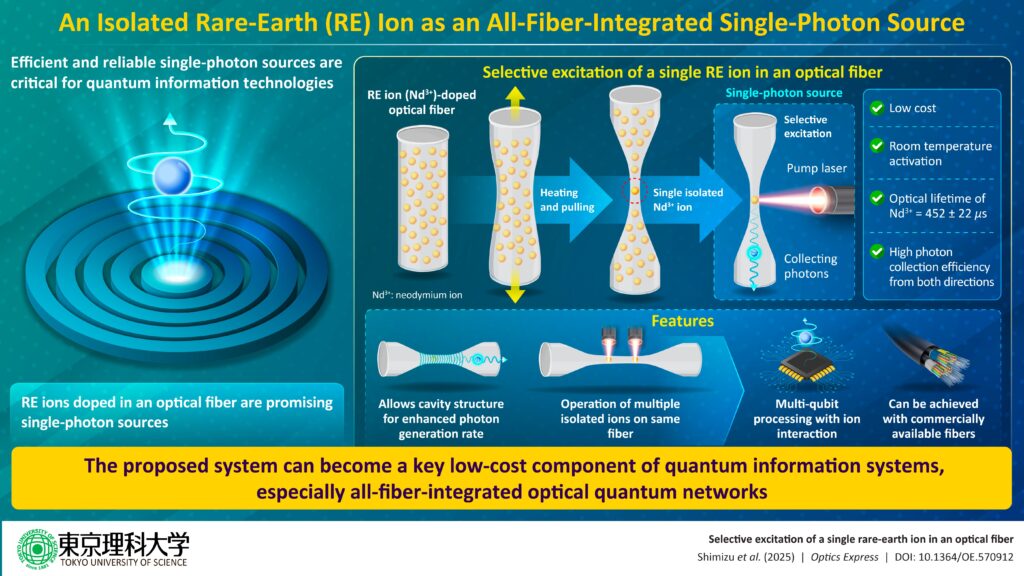As the world races toward quantum computing, scientists are confronting a troubling paradox: the same technology that promises to revolutionize data processing could also render today’s communication systems obsolete.
Quantum computers are expected to crack many of the encryption methods that protect online transactions and global communications. To stay ahead, researchers are developing quantum communication systems that use the fundamental principles of quantum mechanics to create networks that are virtually unhackable.
A cornerstone of this future “quantum internet” is the single-photon source—a device capable of generating one photon, or particle of light, at a time. These photons carry quantum information and travel through optical fibers, forming the basic units of secure quantum communication. But until now, most single-photon sources have been inefficient and expensive to integrate into real-world fiber networks, losing much of their light before it ever reaches the transmission channel.
A research team at the Tokyo University of Science (TUS) believes it has found a breakthrough. In a study published in Optics Express on September 22, 2025, the team, led by Associate Professor Kaoru Sanaka, unveiled a cost-effective, room-temperature system that can directly generate single photons inside an optical fiber.
“In our approach, a single isolated RE ion confined in a tapered optical fiber is selectively excited by a laser to generate single photons,” Dr. Sanaka told Afcacia. “Unlike conventional approaches, where single-photon generation and transmission are separate steps, here single photons can be generated and efficiently guided directly within the fiber with significantly reduced loss.”
The simplicity of this method lies in its directness. Traditionally, single-photon emitters—often quantum dots or rare-earth ions—sit outside the fiber. Their photons must then be carefully directed into the fiber, a process that leads to high transmission loss. By contrast, Dr. Sanaka’s team embedded the emitter within the fiber itself, cutting out the middle step.
The researchers, including Ph.D. candidate Kaito Shimizu and Assistant Professor Tomo Osada, doped a silica optical fiber with neodymium ions (Nd³⁺)—a rare-earth element chosen for its ability to emit photons across a wide range of wavelengths, including those compatible with telecom networks. The fiber was then tapered through a precise heat-and-pull process, reducing its thickness until the individual ions were spatially separated.
This allowed the team to selectively excite a single Nd³⁺ ion using a laser at room temperature, producing single photons that were immediately guided through the fiber’s core. The photons were collected from one end of the fiber and analyzed using autocorrelation, a technique that compares a signal with its delayed version to confirm the emission of single photons.
The results were striking. The team confirmed that only one photon was emitted at a time, and that the photons were transmitted with far greater efficiency than in previous methods where multiple ions were excited simultaneously. “Our approach allows highly efficient transmission of single photons from source to end,” said Dr. Sanaka, noting that efficiency could be boosted even further if photons were collected from both ends of the fiber.
Crucially, the setup operates at room temperature, a major advantage over most quantum technologies that require expensive cryogenic cooling systems. It also relies on commercially available optical fibers, making it a low-cost and scalable solution that could easily fit into existing telecommunication infrastructure.
The implications are far-reaching. With this technology, secure quantum key distribution—an encryption method impossible to hack using classical computers—could become practical for everyday use. Financial institutions, healthcare providers, and even governments could one day communicate through fiber-optic networks immune to cyberattacks.
The research also opens doors for quantum computing applications. “By individually operating multiple isolated ions within the same fiber, it is possible to develop a multi-qubit processing unit. It may also enable qubit encoding protocols,” Dr. Sanaka explained, referring to qubits, the basic units of quantum information.
Future research, he added, will focus on refining photon wavelengths to suit practical uses in spectroscopy, imaging, and optical sensing — all fields that could benefit from stable, high-efficiency single-photon sources.
For now, the team’s innovation stands as a milestone in the march toward quantum connectivity — a future where information moves not just faster, but with unprecedented security. If adopted at scale, their discovery could power the world’s first fully fiber-integrated quantum communication networks, laying the groundwork for a safer digital age.





